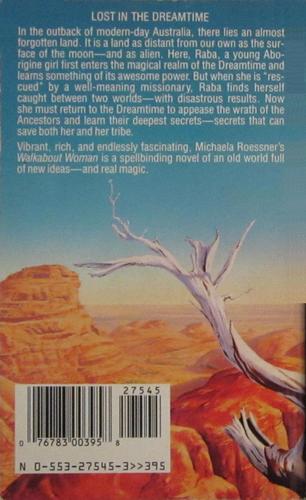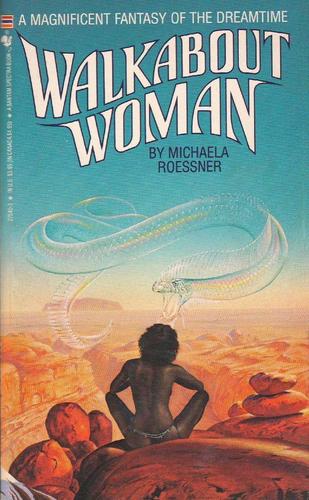Vintage Treasures: Walkabout Woman by Michaela Roessner
 |
 |
Fantasy shelves in the 80s groaned under the weight of Tolkien pastiches, Celtic fantasies, Thieves World anthologies, and a whole lot of Dragonlance and Forgotten Realms books. Books with more original settings, however, or which tapped into non-Western mythic traditions, were a lot harder to come by.
That’s part of what made Michaela Roessner’s debut novel Walkabout Woman so special. Set in the modern Australian outback, the novel offered fascinating glimpses of Aboriginal culture, paired with an intriguing story of a young Aboriginal girl pulled away from her home by a well-meaning missionary. The novel was a nominee for the Mythopoeic Award, and won the Crawford Award. Based almost solely on the strength of this novel, Roessner won the 1989 John W. Campbell Award for Best New Writer.
Michaela Roessner was not a prolific writer, and she produced only three other books in her brief career: the SF novel Vanishing Point (1993), and two historical novels, The Stars Dispose (1997) and The Stars Compel (1999). Since 1999 she has concentrated mostly on short fiction. She’s produced roughly a dozen short stories in the last two decades; her most recent, “The Klepsydra: A Chapter from A Faunary of Recondite Beings,” appeared in the November 2011 issue of F&SF. Walkabout Woman was published in September 1988 by Bantam Spectra; it is 276 pages, priced at $3.95 in paperback. The wraparound cover is by Mark Harrison. It has never been reprinted, but Roessner did self-publish a digital version in July, 2011.
Something so fascinating about non-prolific writers. The enigmatic Ted Chiang comes to mind. Ligotti for the last two decades of course.
Even more fascinating: Gael Baudino. She wrote 12 books over the course of 8 years and then walked away from it all, possibly due to becoming a Quaker.
And Roessner’s ‘The Stars Dispose’ sounds fascinating: “These occult conflicts, in which the Ruggieros and Piera Arista figure prominently, are intricate, abstruse, and almost impossible to follow.” -Kirkus. YES.
> Something so fascinating about non-prolific writers. The enigmatic Ted Chiang comes to mind. Ligotti for the last two decades of course.
I agree completely. In addition to the delights of their work, there’s the often tantalizing mystery of why they didn’t write more.
Ted Chiang is a friend of mine, and we’ve talked several times about why he doesn’t write more. I find his answer instructive. He tells me, “I only write when I have an idea worth writing.”
John,
You must have asked Chiang if he will ever write a novel?
I haven’t, actually. He seems to be fully comfortable with short stories. But I’ll have to ask him that when I run into him again — usually at Wiscon and the World Fantasy Convention.